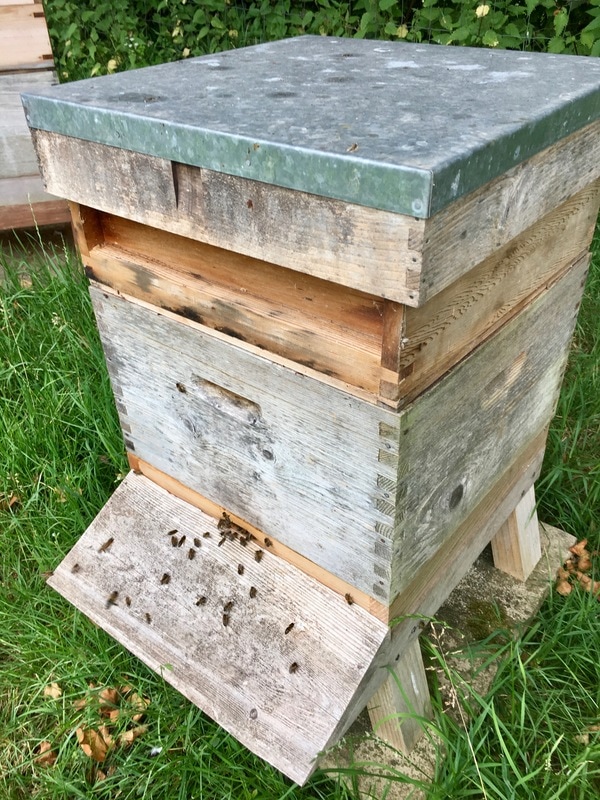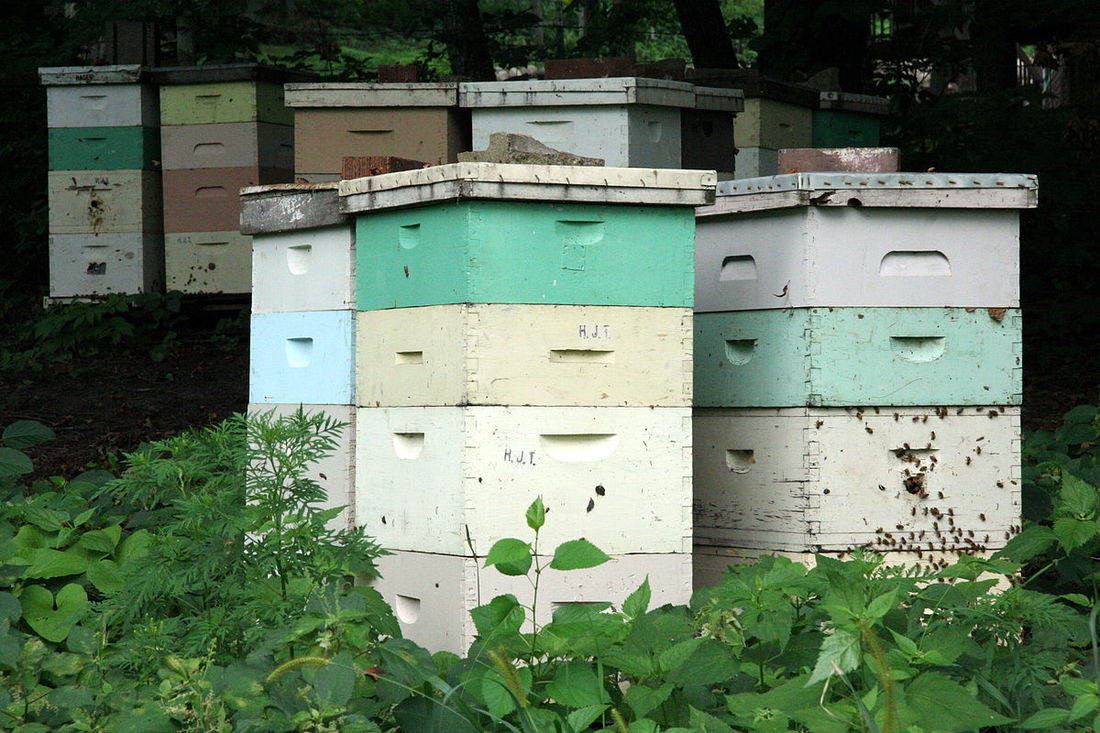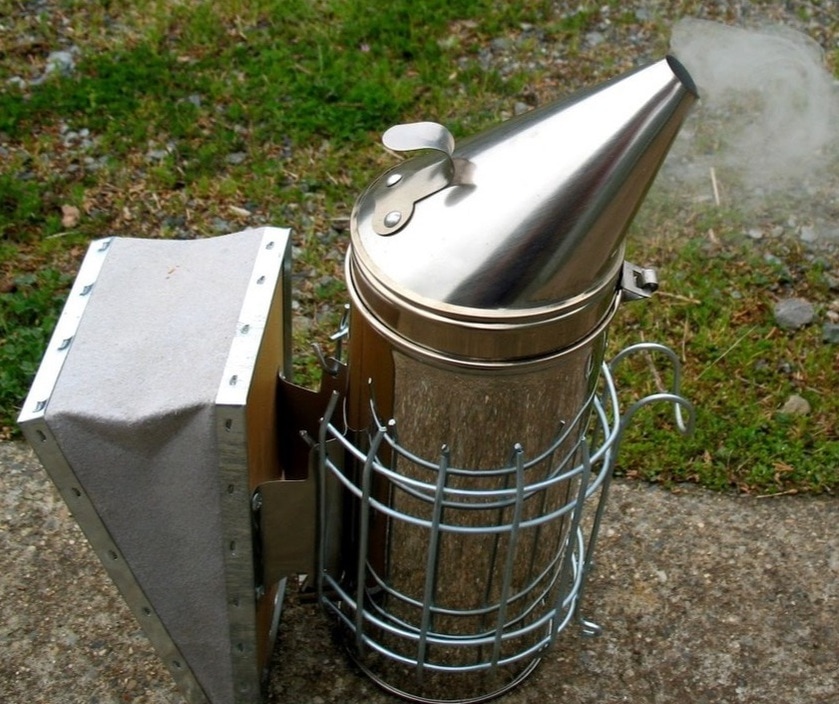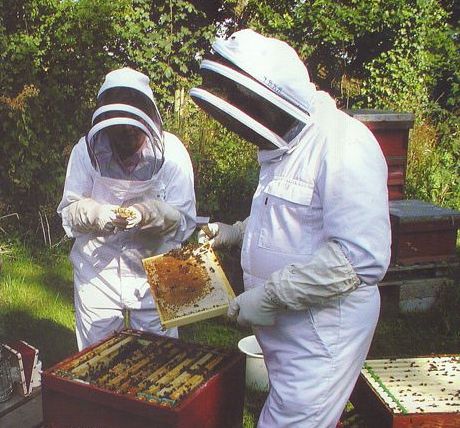Getting Started
Getting started in Beekeeping requires a little forethought and consideration before jumping in.
How many hives should I have? Where will I site them? Where will I get them from? Is there a risk of upsetting the neighbours? How long will it take me to become competent?
The road to becoming competent starts by attending an Introductory Course, preferably before obtaining bees. This is usually held in the Winter in a classroom environment, and followed the following Spring by a Practical Course. It is usually during this practical course that beginners obtain their first colony of bees. The learning curve is quite steep in this first year, and many people return to the course in the second year to refresh their memory, but by the end of the second year a fair degree of competence has been obtained
It is usually advisable to start in a small way, with one hive, progressing to two or more in the second year. It is a good idea to keep, eventually, more than one hive, so that if you should be unfortunate enough to have a colony die out, replacement is within your own hands
It is a common misconception that you need a license to keep bees; this is not true, however siting the hives is important. The principal consideration is that they are placed in a position where the bees will not present a nuisance to either you or your neighbours. Bees do not set out to sting people. It is not in their interest, as they lose their life. But if someone becomes an obstacle in their flight path to and from the hive, then a collision is possible. So the hives should be sited with this in mind.
How many hives should I have? Where will I site them? Where will I get them from? Is there a risk of upsetting the neighbours? How long will it take me to become competent?
The road to becoming competent starts by attending an Introductory Course, preferably before obtaining bees. This is usually held in the Winter in a classroom environment, and followed the following Spring by a Practical Course. It is usually during this practical course that beginners obtain their first colony of bees. The learning curve is quite steep in this first year, and many people return to the course in the second year to refresh their memory, but by the end of the second year a fair degree of competence has been obtained
It is usually advisable to start in a small way, with one hive, progressing to two or more in the second year. It is a good idea to keep, eventually, more than one hive, so that if you should be unfortunate enough to have a colony die out, replacement is within your own hands
It is a common misconception that you need a license to keep bees; this is not true, however siting the hives is important. The principal consideration is that they are placed in a position where the bees will not present a nuisance to either you or your neighbours. Bees do not set out to sting people. It is not in their interest, as they lose their life. But if someone becomes an obstacle in their flight path to and from the hive, then a collision is possible. So the hives should be sited with this in mind.
Sources of Bees
Buying a Complete Hive
This would include a hive, an established colony of bees, and frames containing brood, pollen and honey.
The advantage of this method is that as you are taking over a "going concern", a crop of honey will probably be obtained in the first year. The disadvantages are:
The advantage of this method is that as you are taking over a "going concern", a crop of honey will probably be obtained in the first year. The disadvantages are:
- The age of the queen may be unknown; she could be past her prime.
- The temperament of the colony may be unknown. Temperament can vary between different strains of honeybees, and the last thing a beginner wants is bad tempered bees.
- Endeavouring to control a strong colony with very limited knowledge or experience can be problematic.
Obtaining a Swarm
Swarming is the bees natural way of reproducing. One colony will divide into two, with half the bees leaving the hive to form a new colony elsewhere.
The advantage of starting this way is that a swarm can be obtained at no cost, so it is a cheap way into the craft. A hive will still be required however, to house them. The disadvantages are very similar to those connected with a complete hive:
The age of the queen is unknown. The queen with the swarm is the old queen.
The advantage of starting this way is that a swarm can be obtained at no cost, so it is a cheap way into the craft. A hive will still be required however, to house them. The disadvantages are very similar to those connected with a complete hive:
The age of the queen is unknown. The queen with the swarm is the old queen.
- The age of the queen is unknown. The queen with the swarm is the old queen.
- The origin of the swarm is usually unknown, so there is a risk of disease being present.
- The temperament of the bees is unknown.
- As the bees will have to set up a new home from scratch, they will probably require feeding.
Buying a Nucleus
A nucleus is a small, specially bred colony of bees supported on 4, 5 or 6 frames instead of the usual 10 or 11 in a full sized colony. The nucleus is placed in a normal hive, and encouraged by feeding, to grow into a strong colony. For the outright novice, this is without a doubt, the best way to start. The advantages are:
- Because the nucleus has been specially prepared for you, the queen will be a new queen.
- She will have been bred from a gentle strain (there is no point in breeding from temperamental strains).
- If purchased from a reputable source, there will be little risk of disease.
- It will take several weeks for the nucleus to grow into a full sized colony, in which time the beekeeper's knowledge and confidence will grow.
Finding a SITE FOR your Bees
OUT APIARIES
A quaint term really, but it means an apiary away from your home. For some this is a necessity, as keeping bees at home is simply not an option. For others it’s a way of having more hives, spread over several locations.
|
How do you decide what makes a good out apiary? Land is very easy to find. It’s everywhere, but who owns it, and would they be prepared to let you keep bees there? At events like the Bath & West Show, we are often approached by people with land, who like the idea of having bees on it. All of the offers are well meant, and most are aware of the implications. You should, however, point out to the land owners that regular access is needed at times which might not be convenient for them, and without prior notice. Simply asking locals if they know of a suitable piece of land will bring surprisingly positive results.
|
|
Buying a plot of land is an excellent idea, but pieces of the size suitable for bees, often make ideal pony paddocks, and therefore command a premium.
When you have found some land, don’t commit immediately. You need to ensure that it’s suitable. You are thinking of placing valuable assets at a distance from, and out of sight of your house. A full colony with 3 full supers of honey is worth in the region of £750. |
It looks complicated and somewhat cumbersome, but ask yourself the following questions:
When you have acquired your plot, establish exactly where it is. Orchards, disused quarries and fields don’t have post codes, but they do have grid references. By going to www.gridreferencefinder.com you can establish the grid reference of your ‘out apiary’. Now you can register it with Beebaseat http://www.nationalbeeunit.com , so that you can be informed of any problems within a 5km radius. A relatively new method of establishing exact locations has just come on stream, and is being used by Avon & Somerset Constabulary. It’s called What3words. Google What3words, and you will see that it has divided the globe into 3m x 3m squares, and given each one a unique 3 word address. People can find their current 3 word address on the free what3words app for iOSand Android, which works offline and is ideal for use in areas with unreliable data connection, or on the online map. The 3 word address format is consistent everywhere in the world and available in over 35 languages. Venue. Chill. Tags will take you to the centre of the island in Sherford stream, which is in Vivary Park, Taunton – home of the County Honey Show.
When your out apiary is set up and stocked, put a sign on the fence saying ‘Caution, bees at work’, or similar.
And one last thing. If the land is on loan to you, respect the owners and neighbours.
- Will there be ample forage for the bees? Acres of wheat are a desert to bees.
- Is there a water source nearby?
- Are there other beehives in the area, as too many colonies will diminish the available forage?
- Has there been a disease problem in the area? Somerset is an EFB hotspot
- Is there easy vehicular access? It makes moving hives and heavy supers easier.
- Is it a manageable distance from your home?
- Is the plot big enough for your purposes, should you need to place more hives?
- Is the site visible? Hive rustling is not uncommon, unfortunately. Out of sight, out of mind.
- Mark your hives with a brand – your post code, or name.
- Is the site adjacent to houses, or a road/ footpath? Walkers don’t appreciate being harassed by angry bees, and bees aren’t very traffic savvy, especially when it comes to fast moving vehicles.
- Are children able to access the area? Unsupervised children could endanger themselves.
- Leave something indicating how you can be contacted eg a laminated notice pinned to the gate - with your phone number.
- Padlock the gate if you are permitted to do so.
- Is there shelter from prevailing winds? Strong winter winds can blow hives over, or lift the roofs.
- Is the ground (reasonably) level? Placing beehives on a slope is not a good idea.
- Is there enough sunlight and shade? Ideally, you need some of both.
- Is the ground generally wet & is it prone to flooding? Bees can’t swim.
- Is livestock kept nearby? If so, could you fence the area? Horses and bees don’t mix well & sheep can knock hives over.
- Are there badgers in the area? They love honey, aren’t afraid of bees and can wreak havoc.
- Could you store extra equipment on site? You don’t want to drive 5 miles to collect another super.
- Could your swarms cause a problem? My bees never ever swarm, but apparently some people’s do.
- Is this a long-term arrangement, or could the land be required for something else in the future? Moving bees is a pain.
- How much is it going to cost. Very few people charge rent, but a jar of honey, or two, or three go a long way to oiling the wheels.
- Is there access for emergency vehicles? You never know when you might need one.
When you have acquired your plot, establish exactly where it is. Orchards, disused quarries and fields don’t have post codes, but they do have grid references. By going to www.gridreferencefinder.com you can establish the grid reference of your ‘out apiary’. Now you can register it with Beebaseat http://www.nationalbeeunit.com , so that you can be informed of any problems within a 5km radius. A relatively new method of establishing exact locations has just come on stream, and is being used by Avon & Somerset Constabulary. It’s called What3words. Google What3words, and you will see that it has divided the globe into 3m x 3m squares, and given each one a unique 3 word address. People can find their current 3 word address on the free what3words app for iOSand Android, which works offline and is ideal for use in areas with unreliable data connection, or on the online map. The 3 word address format is consistent everywhere in the world and available in over 35 languages. Venue. Chill. Tags will take you to the centre of the island in Sherford stream, which is in Vivary Park, Taunton – home of the County Honey Show.
When your out apiary is set up and stocked, put a sign on the fence saying ‘Caution, bees at work’, or similar.
And one last thing. If the land is on loan to you, respect the owners and neighbours.
Equipment
BEE HIVE
|
There is one fundamental item of equipment which is required to get started, that is of course a hive. There are several types available (the British National hive is by far the most common hive type in the UK), and the beginner should seek advice before making a decision, but whichever type is chosen, it should consist of a floor, a brood chamber, a queen excluder, at least two honey supers, a crown board and a roof. Frames, beeswax foundation and spacers will be required to furnish the interior of the hive.
|
Tools
Clothing and Other Equipment
|
In order to handle bees with confidence, sound protective garments are essential.
Firstly some sort of coverall is required. A zip fronted boiler suit will do, preferably white, or at least a light colour (some beekeepers think that bees don't like dark colours). To protect the head and face, a hat and veil is required. There are several designs and prices available, again seek advice on which is best for you. |
|
Thirdly a pair of gloves. Beekeeping gloves are usually made from soft leather, however it is generally accepted now that leather gloves are not a good idea for several reasons:
Footwear is usually covered by a pair of wellies. |
You are now ready to become a beekeeper!











